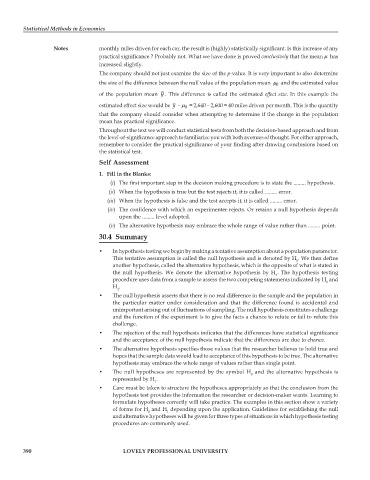Page 395 - DECO504_STATISTICAL_METHODS_IN_ECONOMICS_ENGLISH
P. 395
Statistical Methods in Economics
Notes monthly miles driven for each car, the result is (highly) statistically significant. Is this increase of any
practical significance ? Probably not. What we have done is proved conclusively that the mean μ has
increased slightly.
The company should not just examine the size of the p-value. It is very important to also determine
the size of the difference between the null value of the population mean μ and the estimated value
0
of the population mean y . This difference is called the estimated effect size. In this example the
estimated effect size would be y – μ = 2,640 – 2,600 = 40 miles driven per month. This is the quantity
0
that the company should consider when attempting to determine if the change in the population
mean has practical significance.
Throughout the text we will conduct statistical tests from both the decision-based approach and from
the level-of-significance approach to familiarize you with both avenues of thought. For either approach,
remember to consider the practical significance of your finding after drawing conclusions based on
the statistical test.
Self Assessment
1. Fill in the Blanks:
(i) The first important step in the decision making procedure is to state the ......... hypothesis.
(ii) When the hypothesis is true but the test rejects it, it is called ......... error.
(iii) When the hypothesis is false and the test accepts it, it is called ......... error.
(iv) The confidence with which an experimenter rejects. Or retains a null hypothesis depends
upon the ......... level adopted.
(v) The alternative hypothesis may embrace the whole range of value rather than ......... point.
30.4 Summary
• In hypothesis testing we begin by making a tentative assumption about a population parameter.
This tentative assumption is called the null hypothesis and is denoted by H . We then define
0
another hypothesis, called the alternative hypothesis, which is the opposite of what is stated in
the null hypothesis. We denote the alternative hypothesis by H . The hypothesis testing
1
procedure uses data from a sample to assess the two competing statements indicated by H and
0
H .
1
• The null hypothesis asserts that there is no real difference in the sample and the population in
the particular matter under consideration and that the difference found is accidental and
unimportant arising out of fluctuations of sampling. The null hypothesis constitutes a challenge
and the function of the experiment is to give the facts a chance to refute or fail to refute this
challenge.
• The rejection of the null hypothesis indicates that the differences have statistical significance
and the acceptance of the null hypothesis indicate that the differences are due to chance.
• The alternative hypothesis specifies those values that the researcher believes to hold true and
hopes that the sample data would lead to acceptance of this hypothesis to be true. The alternative
hypothesis may embrace the whole range of values rather than single point.
• The null hypotheses are represented by the symbol H and the alternative hypothesis is
0
represented by H .
1
• Care must be taken to structure the hypotheses appropriately so that the conclusion from the
hypothesis test provides the information the researcher or decision-maker wants. Learning to
formulate hypotheses correctly will take practice. The examples in this section show a variety
of forms for H and H depending upon the application. Guidelines for establishing the null
0
1
and alternative hypotheses will he given for three types of situations in which hypothesis testing
procedures are commonly used.
390 LOVELY PROFESSIONAL UNIVERSITY

